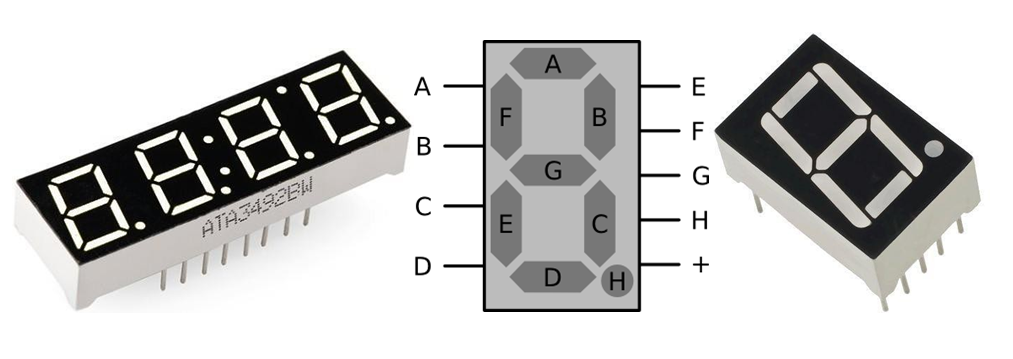Seven-Segment Display
A seven-segment display (SSD) is a widely used electronic component designed to display numerical digits and, in some cases, letters. It consists of seven light-emitting elements arranged in a figure-eight pattern. Each of the seven segments can be independently lit or turned off, allowing the display to show different numbers or alphanumeric characters.
The display's seven segments are typically labeled 'a' through 'g'. By selectively lighting certain segments, the display can form a range of numerical digits from 0 to 9. For example, to display the digit "8", all seven segments are lit, while for the digit "1", only segments 'c' and 'f' are lit. The flexibility of controlling each segment individually allows for the representation of numbers and simple letters.
Seven-segment displays are commonly used in devices that require numeric output, such as digital clocks, calculators, measuring instruments, and some types of microwave ovens and thermostats. They are particularly valued for their simplicity, readability, and ease of integration with microcontrollers and other digital systems. There are two main types of seven-segment displays: common anode and common cathode. In a common anode display, all the anodes of the LED segments are connected to a common pin, and each segment lights up when the corresponding pin is connected to ground. In a common cathode display, all the cathodes are connected together, and a segment lights up when a voltage is applied to the corresponding pin.
The connection method and the driving circuitry can vary depending on the application. For example, when using a microcontroller to drive the display, one may need to use current-limiting resistors to prevent damage to the LEDs. In more complex applications, multiplexing is used to display multiple digits with fewer control lines by rapidly switching between digits.
Seven-segment displays are popular due to their low cost, high visibility, and ease of use in digital applications. They have limitations, such as their inability to display complex characters or special symbols, but they remain a vital component in many consumer and industrial products. Their simple design makes them a reliable solution for devices where numerical data needs to be easily and clearly presented to users.
The display's seven segments are typically labeled 'a' through 'g'. By selectively lighting certain segments, the display can form a range of numerical digits from 0 to 9. For example, to display the digit "8", all seven segments are lit, while for the digit "1", only segments 'c' and 'f' are lit. The flexibility of controlling each segment individually allows for the representation of numbers and simple letters.
Seven-segment displays are commonly used in devices that require numeric output, such as digital clocks, calculators, measuring instruments, and some types of microwave ovens and thermostats. They are particularly valued for their simplicity, readability, and ease of integration with microcontrollers and other digital systems. There are two main types of seven-segment displays: common anode and common cathode. In a common anode display, all the anodes of the LED segments are connected to a common pin, and each segment lights up when the corresponding pin is connected to ground. In a common cathode display, all the cathodes are connected together, and a segment lights up when a voltage is applied to the corresponding pin.
The connection method and the driving circuitry can vary depending on the application. For example, when using a microcontroller to drive the display, one may need to use current-limiting resistors to prevent damage to the LEDs. In more complex applications, multiplexing is used to display multiple digits with fewer control lines by rapidly switching between digits.
Seven-segment displays are popular due to their low cost, high visibility, and ease of use in digital applications. They have limitations, such as their inability to display complex characters or special symbols, but they remain a vital component in many consumer and industrial products. Their simple design makes them a reliable solution for devices where numerical data needs to be easily and clearly presented to users.
